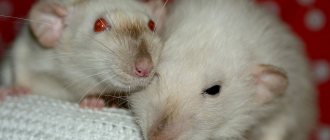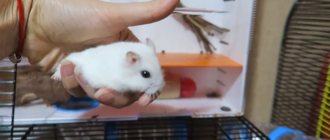Before you run to the veterinarian, you need to try to figure out why your pet is lying motionless. Pay attention to other signs: whether the eyes are closed, how often the rodent breathes. If the eyelids are closed and breathing is calm, the hamster may simply be fast asleep.
Metabolic disorders
Metabolism is the proper functioning of all body systems. Food processing, energy production, removal of unnecessary and harmful products. The central nervous system is responsible for all this, but the glands that secrete hormones have a huge influence on metabolic processes. These include the thyroid and pancreas, adrenal glands, pituitary gland, and gonads. Poor nutrition, poor environment, and hereditary factors affect the functioning of these organs. Violation of their normal functioning leads to a malfunction of the body as a whole. Diseases of Djungarian hamsters are often associated with metabolic disorders.
Read also: Secrets of the lower occipital zone
Diabetes
may develop due to excessive carbohydrate consumption. Hereditary predisposition to the disease also plays a role. You can find out that a hamster has contracted this disease by the characteristic smell of acetone, which comes from the rodent’s saliva and urine. But only a doctor can make a final diagnosis by doing a blood test. Prevention of disease in Djungarian hamsters is a balanced diet, eliminating sugar from the diet, good care and an active lifestyle.
Stroke
How to wake up
It is necessary to create conditions that are exactly the opposite of those in which the hamster went into torpor. Move the cage to a brighter and warmer room, with an air temperature not lower than +20-22 degrees. You can put his favorite “snacks” next to his nose.
The hamster can be wrapped in a warm cloth or placed in cotton wool. And, of course, give him more food so that after waking up he can replenish his strength.
Don’t expect that when you come to your senses, your homeboy will immediately start spinning his favorite wheel. For some time he will behave sluggishly, rest a lot, and only after a day or two all life processes will resume in the same rhythm.
Under no circumstances should you try to warm up your hamster using radiators or electric heaters. Such extreme awakening can only cause harm. A numb body has a lower pain threshold, and the animal will not be able to let you know that it is too hot. The experiment may even end in the death of the pet.
Treating limb injuries at home
Is there a veterinary clinic in the locality where you live? Then don’t hesitate and take your pet there - qualified assistance is provided to you and the rodent. What should you do if a hamster breaks its leg, and there is not even a veterinarian in your locality or there is no way to contact one now?
First
and your most important action is to limit the animal’s movement. Any movement of the damaged paw is accompanied by severe pain.
In case of an open fracture, the wounded limb should be treated, that is, disinfected, and a plaster cast should be applied.
Second
– instead of bedding, use pieces of paper napkins so that the rodent does not dig into the bedding with its damaged paw.
Read also: ✅ How to make reeds with your own hands -
Third
– Provide your pet with proper nutrition. It should contain quite a lot of calcium and protein, that is, in addition to the grain mixture, introduce the following products into the rodent’s diet:
- low-fat kefir;
- the fat content of cottage cheese and yogurt should be no more than 1%;
- white and yolk from one;
- (lettuce leaves).
Fourth
After the first three days of treating an injured hamster, you will be able to observe the dynamics of the therapy. Recovery of the limb will not occur if the rodent's paw begins to dry out or turn black. Here, contacting a specialist is inevitable. Sometimes the animals themselves amputate their limbs by simply gnawing off their paws. This outcome is quite depressing, but do not fall into despair. Hamsters are animals that can live a full life (100%), having 3 legs. Most often, hamsters' limbs do not die - the bones on the paws of rodents grow together perfectly. Try to be very attentive to your small pets. And then you won’t have to go to a veterinary clinic to get qualified help.
Reading time: 7 minutes. Published 04/09/2019
Can hamsters hibernate?
Hibernation is a state during which an animal's body temperature decreases and metabolic processes slow down. Usually in wild animals it lasts from late autumn to spring. Although there is short-term hibernation, which is called torpor or suspended animation - the suspension of vital activity until favorable conditions occur.
As a rule, this condition is typical for bears, gophers, ground pigs, bats, frogs and snakes. Hamsters can also hibernate. Only this condition is slightly different in wild and domestic rodents.
A wild hamster hibernates to protect its body from harsh winter conditions. He makes provisions for the winter in advance, builds up fat, and tries to save energy. When spring comes, the animal wakes up.
Not all rodent owners know whether domestic hamsters hibernate. This is possible when the conditions for keeping animals become unfavorable. This is how the self-preservation instinct kicks in. As living conditions worsen, hamsters become torpid - this condition is an alternative to hibernation.
Almost all hamsters can hibernate at home: Syrian, Djungarian, long-tailed, common, Angora, and albinos. This is typical for them, just like their wild relatives.
Gray hamsters that live in the north do not hibernate. They dig deep burrows to keep warm during cold weather.
Syrian hamsters hibernate more often than other breeds; their sleep is deeper and longer. Djungarians go into suspended animation for a short time.
In nature
The rhythm of life of wild rodents depends on the time of year. In the summer they begin to stockpile food for the winter. The animals stuff their cheeks with food, which they carry to the pantry near the hole. Rodents will feel the approaching cold even from underground.
In winter, hamsters hibernate when the temperature drops below zero and the greenery disappears from the fields. They winter in a hole, which is located at a depth of 1–2 m. Next to the warm dwelling there is a pantry with root crops, grains, vegetables, fruits and other supplies.
The rodent goes to bed when it has eaten and gained the required amount of subcutaneous fat. However, it cannot physiologically accumulate enough nutrients to sleep soundly all winter. This could cost him his life.
Wild hamsters do hibernate during the winter, but periodically emerge from this state. Then they visit their pantry to have a snack and go back to sleep. This rhythm of life allows rodents to survive the “hungry” season. Their reserves are sufficient for the entire winter and even more.
Hamsters hibernate until about the end of February. But they do not rush to the surface after waking up. The animals are waiting for the snow to melt from the ground and the air temperature to rise.
While waiting, they feed on food from the pantries. After about 4 weeks they come to the surface. While the young greens have not yet grown, hamsters feed on last year's grains, seeds or berries. Females leave the hole closer to the mating season.
Interesting! A wild hamster sleeps all day and goes out hunting at night. Before dawn, he goes down into the hole, eats and falls asleep again. This rhythm of life is also suitable for domestic rodents.
Reasons why a hamster constantly sleeps at home
The activity period of different hamsters differs: some sleep during the day and wake up in the late afternoon, others fall asleep early in the morning and play in the afternoon. But most are nocturnal.
Active hamsters sleep 8 hours, while more passive ones sleep from 10 to 14 hours. This time is enough to recuperate. If an animal sleeps more than 14 hours a day, this indicates health problems. Although for older pets this may be the norm.
Experienced breeders will confirm that domestic hamsters enter short-term hibernation under the influence of such factors:
In preliminary experiments, attempts were made to revive partially frozen hamsters by warming the heart area using a microwave generator or infrared rays.
Cardiac activity was initially restored, but soon the heart stopped contracting even before the limbs and skin on the body of the animals, which had been frozen for more than 15 minutes, had time to thaw. Lovelock designed a small device for
diathermy to thaw ice on the animal's entire body as quickly as possible. The device consisted of a generator operating at a frequency of 27 MHz and having a power of approximately 120 watts.
The animal was placed between two electrodes connected to an external resonant circuit connected to a generator. Slowly cooled hamsters, which were frozen for 70 minutes at -5°, were completely thawed 3 minutes after the start of heating using the specified device. Diathermy was not stopped even after thawing, so that the temperature of the device increased from 0 to 10° at a rate of approximately 2° per minute. During this time, regular active heart contractions were restored. Artificial respiration was maintained by blowing air into the lungs through tubes inserted into the nostrils. Then diathermy was stopped and rewarming was continued using a table lamp until the temperature in the colon reached +10°. After about 1 minute, at a temperature in the colon of about 11°, pulsation began in the jugular vein and other peripheral vessels. Good blood circulation was quickly restored, and if artificial respiration was not stopped, the tongue, mucous membranes and skin turned from ash-gray to pink. The temperature in the colon continued to rise at a rate of approximately 1° per minute. Weak intestinal motility could be seen through the abdominal wall. When the temperature in the colon reached 15°C, the animal's whiskers began to twitch, the tongue and lower jaw began to move, and reflexes to touching the limbs and abdomen appeared. When the hamsters, which were frozen for no more than 160 minutes, reached 17-19°C inside their bodies, they began to breathe spontaneously, deeply but unevenly.
Subsequently, functional recovery depended on the duration of freezing, as well as on the final temperature in the colon. Hamsters cooled for 50 minutes or less came to life. They trembled violently and made tense movements with their limbs and whole body until they managed to get to their feet. After a short “respite,” the animals began to move; gradually their confident gait and usual “exploratory” behavior were restored. After a few hours, they began to drink, and later eat. 17 out of 20 hamsters, cooled for various periods of time from 50 to 70 minutes, regained their normal appearance, but 7 of them died within the first day, and 2 died within 10 days after freezing and revival. The greatest number of deaths was observed among hamsters chilled for more than 60 minutes. The remaining 8 animals out of 20 lived for various periods of time up to 450 days and were in good condition all this time. Only some hamsters, cooled for 70-90 minutes, regained their normal appearance and movements, and the majority died within the first day. In fully recovered animals, the temperature in the large intestine dropped sharply below -1°. Only one hamster, frozen for 96 minutes until the temperature in the colon reached -1.4°, initially quickly and completely restored its vital functions, but after 18 hours it died. Other animals frozen for 90 minutes or more experienced convulsions and died a few minutes after spontaneous breathing was restored, approximately 2 hours after thawing. It is noteworthy that literally all the partially frozen animals survived, and most of the hamsters, which were frozen for 50-60 minutes until cold rigor set in, not only came back to life, but also lived for a long time in apparently good condition.
Other methods of resuscitation were also used in the experiments, including faster rewarming using diathermy, immersion in a bath at +40°C, or slow thawing and rewarming either at room temperature (17-22°C) or using a 100-watt electric lamp. Partially frozen hamsters could be revived by all of the above methods (provided that artificial respiration was continued), but there were more deaths in the first day after resuscitation and significantly fewer cases of stable long-term survival were observed.
An approximate determination of the proportion of water that turned into ice in the body of hamsters warmed using diathermy showed that none of the animals in which more than 55% of the water froze recovered their normal appearance and behavior, although all of them breathed independently and in many trembling was observed. When 40-50% of the total volume of water froze, most animals regained their normal appearance and behavior. However, many of them died in the first 48 hours after revival. Only about one third of the animals lived more than 10 days after thawing. They lived for several months and outwardly looked quite healthy. There were no early deaths or incomplete recovery of function among hamsters exposed to cooling for less than 45 min at -5°C. This group included animals in which 30-40% of the total volume of body water turned into ice, with 50-58% of the water frozen in the brain, and 60-90% in the skin. Interestingly, spontaneous breathing and trembling were observed in hamsters in which 57-70% of the water froze, and in animals cooled for 170 minutes, in which 70-76% of the water turned into ice, heart contractions were restored. Ultimately, we concluded that using the above methods, adult hamsters do not survive chilling for more than 1 hour at -5°C, or having more than 50% of their water freeze out, or having their core temperature drop below -1°C (approximately). In hamsters that were chilled for no more than 10 minutes in a bath with a temperature of -8 to -10° or at an air temperature below -10°, all vital functions were never fully restored. It is clear that there is no chance of successfully storing partially frozen animals in a state of suspended animation at temperatures close to zero. One can hardly hope for their revival even after complete freezing at lower temperatures.
If you find an error, please select a piece of text and press Ctrl+Enter.
Temperature fluctuations, daylight hours - all this affects rodents. Once you find the motionless body of your beloved homa in a cage, you shouldn’t immediately get scared. Few people know that hamsters, even living at home, can sometimes fall into torpor.
This is not a seasonal long hibernation, like that of a bear. A hamster physiologically cannot accumulate enough nutrients in its body to fall into a sweet, carefree sleep for several months. This could be fatal for him.
With this article we want to help the owner of a tame hamster, so as not to “break the woods” in the situation that has arisen, or to mistakenly bury a sleeping pet.
Hypothermia or overheating
Both of these factors seriously undermine the pet's health. The fact is that hamsters themselves love warmth, so drafts have a detrimental effect on their health. But at the same time, in nature they live in dark burrows, so direct sunlight or stuffy space also undermines the health of the animal, even to the point of death. This can be very unexpected for the owner and he will never be able to understand why the hamster died. Ideally, the room where the cage is located is +20-22 degrees.
How hamsters die and what sensations they experience before death, we, the owners, cannot understand. But we can organize proper care for the animal and thereby prolong its life.
What to do if your hamster doesn't move? What could be the reasons? Hamsters can hibernate and during hibernation their heart rate and breathing rate drop. Sometimes it is even difficult to tell whether the hamster is sleeping, or whether the reason is different. If you find that your hamster is not moving, here is what to do.
Sleeping or dead?
This is not difficult to determine. The main thing is to be patient.
- In a state of torpor, the hamster’s body, although cold, hard and motionless, can still hear its heartbeat. It is rare - only a few beats per minute.
- The animal also occasionally continues to inhale and exhale. Hold a mirror to its muzzle: if the hamster is alive, after some time traces of fogging will appear on the glass from its breathing.
Symptoms of diseases
How can you tell if your hamster is sick? This question interests many breeders of small pets. A healthy hamster has beautiful shiny fur, leads an active lifestyle, especially at night, and shows interest in the world around it. The animal eats food with appetite, makes supplies, and arranges its home. The Djungarian, the Syrian, has clear, clean eyes and an expressive gaze.
Important! You can understand that a rodent is sick not only by external signs, but also by the changed behavior of the hamster.
Main symptoms of diseases:
- decreased activity, lethargy, apathy;
- deterioration of fur condition (wet fur);
- severe itching;
- the appearance of scratches, bald patches, wounds, ulcers on the body;
- discharge from the nose, eyes;
- increased thirst;
- allergies, skin rash;
- bowel dysfunction (diarrhea, constipation);
- frequent urination;
- pallor, cyanosis of mucous membranes;
- sticky eyelids;
- the presence of blood and clots in the urine;
- disturbance of breathing, heart rhythm;
- accumulation of wax and dirt in the ears;
- yellowness, peeling of the skin;
- loss of cheek pouches;
- impaired coordination of movements;
- boils on the body.
In case of injuries or sprains, the hamster limps, sits constantly in the house or hides in the corner of the cage. The rodent loses a lot of weight or, on the contrary, gains weight and gains weight too quickly.
Ringworm in a hamster
Advice! Take a good look at your pet's home. If a hamster suffers from indigestion, cystitis, or endocrine pathologies, an unpleasant specific odor appears, the feces will be liquid, and the space will be filled with excrement.
If the hamster has lost weight, refuses its favorite treats, has watery eyes, swollen eyelids, the pet has become inactive, shows aggression, is breathing frequently, or other symptoms uncharacteristic of a healthy animal are noticeable, you should not ignore the problem.
If your dwarf or Syrian hamster is sick, do not self-medicate. If you discover that the rodent is sick, take it to the veterinary clinic or call a veterinarian at home. The choice of treatment methods depends on the root cause that provoked the soreness.
Diseases of the genitourinary system in hamsters
Cystitis in a hamster
Cystitis in a hamster is a disease that affects the genitourinary system
- Causes - The causes of cystitis can be both mechanical damage and nutritional disorders. It is also possible that the disease may appear due to the lack of the proper amount of water in the diet;
- symptoms include frequent urination and increased anxiety;
- treatment is carried out by using drugs such as buscopan. If after a course of taking medications the condition does not improve, it is necessary to re-diagnose using x-rays.
Habitats and how to arrange a cage. Diseases of Djungarian hamsters
Since some people keep Djungarian hamsters as a pet, their habitat is a cage or a specially equipped terrarium with oxygen supply. Thus, a person can easily track the life cycle of animals. There should be no high structures in cages and terrariums
. These animals are so agile that they are sometimes clumsy, and this can cause further injury, for example, if they fall from a height. If your hamster falls, it may get bruised or scratched.
, which in turn can escalate, bringing with them more serious consequences. Close observation with due attention to the hamsters will give you the opportunity to promptly notice any deviations from the usual norm.
Do hamsters hibernate: in nature and at home
In nature
When the temperature outside drops, Homa understands that it’s time to get some sleep. In nature, hamsters, like many small rodents, climb into a deep, warm hole during the cold period of time, which they dig in the ground at a depth of 1-2 meters.
In his “apartment,” in addition to the living room where he rests, there is also a chamber designed for storing supplies, which the owner periodically visits in winter during periods of wakefulness. His provisions consist of vegetables, root vegetables, stolen from farmers' fields, as well as berries, fruits, and grains.
Few people also know that hamsters are far from vegetarians. In the wild, they are aggressive and very dangerous predators. And on occasion, they enjoy feasting on caught insects and small animals.
The hamster emerges from its winter burrow no earlier than the end of February, when the earth finally freezes. At the same time, his “sleepy” period has long passed.
After him, the “cheeky, furry owner” waits for some time and does not appear on the surface of the earth. It feeds on what is left in its pantry, and only after a month does it open the entrances to its burrow.
There is no young greenery in the fields yet, and at first he has to eat what he finds on the ground after the snow melts - last year's seeds or berries that fell from the bushes.
Females emerge from winter shelters even later - at the beginning of the mating season.
At home
The onset of hibernation is a protective reaction of the rodent’s body from unfavorable conditions for life: lowering the temperature, decreasing the amount of sunlight, lack of food in nature. Therefore, it is most likely that your hamster will “decide to sleep off in winter” if:
- Hamsters are big sleepyheads. you keep it in a cool room: if the temperature can drop to +15 degrees, stupor cannot be avoided;
- a cage with a hamster is in your bedroom, in which, when you leave for work in the morning, you do not open the window shades;
- the animal has to endure long-term transportation or some other stress during the cold season;
- lack of vitamins and nutrients in the rodent menu.
Numbness, hibernation is a slowdown of all vital processes in the body.
Main signs of numbness
- The heart begins to beat much less frequently; its beats may not be audible at all.
- The body cools down.
- The muscles become stiff.
In a word, all signs of lifelessness appear.
Old age
The life expectancy of the animal is short: from a year to three maximum. Moreover, the hamster still has a chance to live in captivity: food is at hand, there is not much stress, the house is cozy and warm. And yet, even old-timers can last no more than 3.5 years. The fact is that all rodents, without exception, have a heart that beats too fast - 180 beats per minute. Under such loads, it simply wears out and the animal dies.
Along with the heart, regeneration processes slow down as the animal ages. Having fallen ill, it is difficult for him to cope with the illness. Everything, in general, is the same as in humans: teeth fall out, joints and muscles hurt, internal organs semaphore.
What do healthy hamsters look like?
In principle, it is easy to distinguish a healthy hamster from a sick one. In normal condition, the animal has beautiful, shiny fur, smooth breathing without shortness of breath, and no discharge from the eyes and nose. In terms of behavior, the animals are curious, playful, with a good appetite, and active (if this is the time of wakefulness). It is also very important to assess the condition of the eyes; they should not only be clean, but also clear and shiny. Healthy hamsters have a dry nose.
Bites
By nature, hamsters are loners. But often breeders keep several individuals in one spacious cage. When sorting out relationships, hamsters can fight and bite each other. Wounds quickly become infected, so they need to be quickly treated with a disinfectant and, if necessary, antibiotic powder applied.
Hamsters live on average 3 years. Diseases most often threaten them in the first months of life and at an advanced age. Owners should remember that a lot depends on their attention in matters of pet health.
The disease is often triggered by stress. Stress can be caused by:
- the appearance of a new neighbor in the animal’s house;
- overcrowding in the cage;
- relocations and travel;
- violation of the usual routine;
- changing the usual place of the cell.
If you pay enough attention to your hamster and take responsible care of his hygiene and comfort, he will delight you with good health and a cheerful disposition.
“Syrian hamsters may hibernate when the ambient temperature drops sharply, when the animals are experiencing a lack of water, etc. A hibernating hamster may feel hard and cold to the touch, with very little breathing. Careful observation of such a hamster will show that its chest continues to move at certain intervals. If the hamster has not prepared for winter, and hibernation occurs unexpectedly, the animal must be awakened to avoid dehydration and starvation. The hamster needs to be placed in a warm place, or the temperature in the room in which the cage is located should be increased. The hamster should not be placed near open fires, heaters or radiators. With gradual awakening, the hamster will begin to move and tremble, its body temperature will gradually increase, and its breathing rate will increase. Full awakening from hibernation usually occurs within 30-60 minutes.” (With)
“Hamsters do not hibernate, but when the ambient temperature drops to 10 degrees they can fall into torpor. A hamster can be brought out of such a stupor by warming it in the palms of your hands.” (With)
“Many animals hibernate during the winter to survive harsh living conditions such as cold and lack of food. During hibernation, the animal's metabolism decreases significantly, resulting in energy savings. Breathing and blood circulation slow down, body temperature decreases. For example, the body temperature of marmots drops so much that it exceeds the ambient temperature by only 3°C. If the temperature in their burrow is 8°C above zero, then their body temperature is about 11°C! But Djungarian hamsters follow a different strategy to survive the cold winter in their homeland. They do not hibernate, but remain active throughout the winter. However, in order to save maximum energy, during rest they fall into so-called torpor. Torpor refers to a physiological state that occurs in some small mammals. During torpor, metabolism drops to a minimum, so that all body functions are simultaneously maintained on a “low flame.” As a result of this, the animals become completely inactive and remain in a state of bodily rigor. There are practically no reactions to external stimuli in this state. Unlike hibernation, torpor does not occur at a certain time of the year, but at a certain time of day. Thus, sleepy torpor is much shorter than hibernation and lasts several hours during the day when the animal is inactive. The fact that Djungarian hamsters can fall into torpor during inactivity in winter was revealed as a result of laboratory studies. The change between the active phase and the torpor phase occurs in a cycle that repeats every day. This cycle begins approximately 30-60 minutes before sunrise, when numbness sets in, which begins with a drop in body temperature. The animal remains in winter rigor for approximately 4-9 hours. At the end of the torpor phase, the body temperature of the Djungarian hamster drops to approximately 20°C. Moreover, unlike hibernation, body temperature does not depend on the ambient temperature. Thus, there is no difference whether the Djungarian hamster’s ambient temperature is 5°C or 15°C; in both cases, the animal’s body temperature will not fall below 20°C. At the end of torpor, the animals slowly wake up and remain active the rest of the day, spending most of the time searching for food. When morning twilight sets in, Djungarian hamsters again fall into torpor, and a new cycle begins.”
Everyone knows that individuals from the hamster family do not live very long. However, babies tend to hibernate, and therefore, if the hamster does not move and is breathing heavily, it is worth making the first inspection yourself. Usually the first signs of the disease appear almost immediately and are noticeable even to an inexperienced breeder. If the pet lies on its back, squeaks, and after trying to turn it onto its stomach, jumps up and runs to the opposite corner of the cage, most likely it simply fell and could not turn over on its own.
CAB HEATING TRICKS
- Towel: If your home is very cold or where you live you are experiencing a cold wave, a good way to warm up your hamster cage is to use a warm towel with an iron. All you need to do is take the towel that covers your pet's living room floor, heat the towel to medium heat with an iron, and place it on the floor of the cage, covering it with sawdust. This way you will heat your entire area.
- Prepare a hot compress: If your pet is very cold and you notice that he is still cold, a good solution is to prepare a warm compress. It's very easy to make, all you need is a sock and rice. What you need to do is fill a stocking with rice and tie it in a knot or sew it, put it in the microwave for a minute and place it next to the animal to cover it with. This trick is not suitable for all hamsters, as if your pet is very curious, he will be tempted to chew the stocking, in which case you should remove it as soon as possible, as if your pet swallows the piece, it can cause serious stomach problems. so be careful.
- Thick Fabric: Another good alternative to heating your pet's home is to cover the cage with thick fabric, always being careful not to reach and chew through it, and to ensure there is ventilation in any part of the cage.
Temperature-related disorders
If the hamster did not show the slightest signs of illness and suddenly fell into an unconscious state, it may be hibernating. In the natural environment, Djunga hamsters retire in winter, experiencing cold weather, periods of lack of food and insufficient lighting. The other extreme is overheating of the hamster, and this is much more dangerous than cooling, since the small animal is absolutely defenseless against high thermometer readings. It is overheating that most often becomes the cause of death for a rodent.
Low room temperature
Turning off the heating or leaving a window open for a long time on a frosty day can cause the hamster to fall into torpor. In this case, the body will be very cold, and the heartbeat will slow down significantly - to one beat every fifteen seconds. A sleeping hamster barely breathes and due to its small size it is quite difficult to determine how intense the breathing is and whether it exists at all. But if the body is soft to the touch, this means that the rodent is alive.
To awaken it, you need to move the cage to a room with a temperature above +20 degrees. The hamster will wake up in 2-3 days and care should be taken that the feeder and water bowl are full when he wakes up. This is especially important, since during hibernation a rodent wastes a very large amount of energy and its health will depend on how quickly it replenishes it with food. A hamster left hungry after hibernation may develop serious liver problems.
This method of awakening is optimal, since it is close to how a hamster wakes up from hibernation in its natural environment, but the process can be accelerated:
- Wrap the hamster in a warm cloth or down mitten, place it in a cage and move it to a room with a high temperature.
- Fill several bottles with hot water, place them in a row and place the cage on them. Heat will be transferred through the bottom, warming the hamster
Important! Try not to let your hamster hibernate again. To do this, you need to maintain the temperature in the room where the cage is above +20 degrees, make sure that a sufficient amount of sunlight penetrates into the hamster’s house, and that the rodent always has the necessary amount of food and drink.
Heat
Exposure to high temperatures has an extremely negative effect on hamsters. These animals have very dense fur and completely lack protection from overheating - they do not sweat and cannot breathe through their mouths.
You can tell that a hamster is overheated by the fact that it does not move and is breathing heavily, or its coordination of movements is impaired and it is generally weakened.
Heatstroke can be caused by the following situations:
- Transport by car
- A cage placed on a windowsill or balcony so that the hamster is exposed to direct sunlight
- The animal's house is located next to the heating devices
- There is not enough air in the room where the hamster is located and it is very humid
Important! Heat stroke for a hamster is most often fatal if all necessary measures are not taken very quickly.
Possible reasons
If the hamster is shaking and trembling, then this indicates deviations from its usual state, and the reasons may be illness, muscle or nervous disorders, stress, changes in temperature, or exit from hibernation.
Read also: Files began to open with hieroglyphs
In any situation, a trembling pet should never be left unattended. Examining your environment and keeping an eye out for any other unusual symptoms may help determine the cause. Meeting the minimum requirements and having enough food and water can often help. If symptoms persist and there is no response to external stimuli, it is best to have the dog examined by a veterinarian.
Unsuitable room temperature
The hamster actually shivers and shakes from the cold if the housing area is cool. The animal needs a comfortable environment with a temperature of +20...+23°C throughout the year. Cold conditions can lead to colds, and muscle tremors keep the body temperature stable.
At extremely low temperatures (below +15°C), hamsters sometimes go into a state similar to hibernation. This condition of reduced activity aims to conserve energy. The pet hibernates and may appear lifeless, its eyes are closed, but it is still breathing. If this happens, then you need to immediately take the pet to a warmer room and warm it up, gently stroking the body.
As the rodent gradually warms up, vitality and activity return, and it begins to tremble slightly. The warming up process can take up to an hour. Monitor your pet closely for his return to normal, and contact your veterinarian if any difficulties arise.
The cage should be placed in a warm place and provided with fluffier bedding. At high temperatures in the room, overheating and dehydration are possible - the hamster lies motionless, breathes heavily and trembles. He needs to drink a lot to lower his body temperature.
High body temperature in a pet
A hamster will be lethargic, panting and shaking if it has a fever and the body is unable to function properly and thermoregulate. Rodents are warm-blooded mammals and have a normal temperature of +37.5°C.
An increase to +39°C can be a cause of stress, overheating, or indicate the onset of an infection or respiratory disease, and above +39.5°C is a sign that the pet is seriously ill and urgently needs to consult a veterinarian.
Read also: How to select all tables in Word
Before the visit, you can try to bring down the temperature by wiping the fur and ears with cool water or applying ice packs to the animal’s body for 2-3 minutes through a layer of cloth to prevent hypothermia.
Cold
Hamsters can catch colds just as easily as humans. Moreover, the disease easily passes from humans to rodents. Therefore, if you feel unwell, it is better to stay away from the animal's cage until you recover. When keeping several pets together, it is best to isolate patients from the rest for a while.
Symptoms of colds in hamsters are similar to diseases in humans:
- breathing problems, wheezing;
- sneezing, runny nose;
- trembling from fever;
- lethargy;
- dull fur.
In this case, it is recommended to seek the advice of a veterinarian, as this may be a sign of infection or allergy. In such cases, it is necessary to thoroughly clean the cage. If it is an allergy, the hamster will return to normal and the trembling will eventually stop. If this does not happen, then there is a suspicion of an infection, which can be fatal without timely treatment.
Other diseases typical for pets
Often the reason that a hamster lies, does not move, does not eat, does not drink, but breathes, are infectious and viral diseases. In such cases, it is advisable to pay attention to additional signs, since in the absence of timely medical assistance, the hamster may die.
Pneumonia
Pneumonia, or “pneumonia,” can occur if the cage has been left in a draft or in a cool, humid room, such as a bathroom, for a long time. Additional signs of its development, in addition to frequent breathing, are:
- wheezing, gurgling in the lungs, which can be heard without additional equipment;
- presence of nasal discharge;
- lack of physical activity, lethargy;
- lack of appetite.
In such cases, it is best to call a ratologist, because the animal will need intensive injection therapy for 10-14 days. Only a specialist can prescribe medications. However, rapid breathing can cause heart failure. Upon examination, only a veterinarian will be able to indicate the real reason for this behavior.
Agony
If the hamster lies motionless, his eyes are open, and his breathing is heavy, he is most likely in his death throes. This often occurs after the animal falls ill a few days before the onset of such a condition. It’s a pity that if the hamster is breathing heavily and lying on his back, most likely there is no way to help him. An experienced veterinarian will suggest performing a euthanizing injection in such cases.
To make sure that the baby is really in agony, you need to remember whether he had diarrhea in the last 24 hours, whether his stomach suddenly increased in size and whether the pet lost weight. Hamsters cannot get sick for a long time because their metabolism is too fast. For this reason, you should immediately call a veterinarian or go to him for an appointment yourself, because hamsters “burn out” literally in a day or two.
BUILD A HOUSE INSIDE A CAGE
Put him at home to sleep. It will protect your animal from drafts. Ideally, this house should be plastic and without a bottom so that fungi do not accumulate. If you don't have one, you can do it yourself, it's very simple and very quick to do, here's the guide:
Materials:
- The sticks are wooden, you can use an ice cream stick or buy it yourself.
- Ruler.
- Non-toxic glue.
Choose the size you want your hamster's home to be, for this you will need to take into account the size of your pet, the cage and the space you want them to occupy, keep in mind that they don't need anything big. to enter now They are very elastic, and although we see them as balls, most of them are hair. After you make small sizes of sticks and sand them to make the base of your house, it is important that you sand them so that our pet does not get hurt and that we do not paint the sticks as it is toxic to hamsters.
A house inside the cage will help protect the animal from the cold.
Use as little glue as possible and glue the sticks together to form the base. Once you have the base ready, build the roof of your house, for this you will need less sticks. After this, build a wall that will be reinforced and you will have a ready home for your hamster. You can look at different photos on the internet and build a house on them as you wish, remember that the limits are set by your imagination and the only thing you have to remember is that the materials you use cannot be chewed by your animal. so as not to be dangerous for him.
Hamster is breathing heavily
If you have a hamster in your home, you already know that these pets have a relatively short lifespan. In situations where the animal lies and does not move, or does not breathe, or maybe barely walks, or has become inactive, it is impossible to avoid excitement, in such cases it is necessary to act very quickly to help your pet. If you understand why your pet behaves so unusually, unusually for him, then you will have a high chance of saving your pet. Let's consider why an animal can breathe heavily, but at the same time opens its mouth, also why it may be inactive or not walk.
MUST HAVE A BED
Adding toilet paper or blotting paper to your home will encourage your little pet to peck at the paper and create a warm bed for themselves. The only thing you should remember in this case is that the paper should not have a smell, as this is harmful to our hamster and can lead to his poisoning. Likewise, if you want to add a little warmth to your home, place sawdust on your pet's floor. Sawdust, in addition to the fact that it perfectly absorbs odors (mainly urine), is also a good thermal insulator, so your animal will be even warmer in your home.
A bed made of paper and sawdust is a very good option for a hamster to find warmth.
Proper nutrition
There is a wide variety of food for rodents on display at pet stores. However, despite what the labels say, not all of them are created equal. Cheap food is not suitable for feeding hamsters - they are usually of poor quality, incorrectly balanced, and do not contain all the necessary substances and vitamins. There have been cases where rodent poison was found in food, which caused the death of pets.
For normal functioning, hamsters need balanced dry food. It should include cereals, plant seeds, herbs and flowers, as well as protein supplements in the form of dried insects.
It is important to give hamsters allowed vegetables and fruits. You can feed hamsters cucumber, zucchini, broccoli, cauliflower, lettuce, turnips, radish. Types of hamsters that are not predisposed to diabetes can be given pumpkin, carrots, fruits and dried fruits.
It is forbidden to give onions, white cabbage, sorrel.
Is it worth waking up?
Hamster breeders do not give a clear answer to this question. You will have to make a decision yourself, based on the data presented below.
Not worth it
On the one hand, in nature, a hamster approaches hibernation consciously and with full responsibility. He conscientiously eats up the subcutaneous fat layer so that he has something to eat in his sleep.
And there is an opinion that if the hamster is not woken up, unprepared - not well fed - he may simply die in his sleep. But in nature, when he gets hungry, he wakes up and “stomps into his pantry to inspect the supplies”! What's stopping him from doing this in a cage?!
Proponents of not forcibly removing a hamster from a state of “sleepy coma” believe that all life processes in the body should occur naturally, without external gross interference. Hibernation can last from several hours to several days.
By the way, what speaks in favor of rodent hibernation at home is the fact that those of them who “switch off” in winter live longer lives than those who “don’t sleep” in the cold season. True, winter sleep in animals negatively affects the appearance of cubs: they are born less often and in smaller numbers.
If you decide not to wake your pet, help him wake up comfortably. Insulate the cage, for example, put a lot of cotton wool in it and carefully immerse the hamster in it.
Nearby, prepare a “self-assembled tablecloth” with delicacies for him, so that when he wakes up, he can refresh his strength.
Costs
The baby, numb from the cold, needs to be woken up. In making such a decision, the fact that at home there is absolutely no need for a hamster to hibernate often plays a role.
And his further rhythm of life should not be disrupted by such a random incident.
The owner corrects errors in care, “revives” the pet and no longer allows it to “fall asleep.”
Fungal infections
Fungi parasitize the skin epithelium of furry animals and can be located on the paws and ears. As a result, hamsters develop various sores, dandruff, and itchy skin on their bodies. If the problem is not solved in time, the animal will scratch itself into deep scratches, bacteria will settle in them and inflammatory and putrefactive processes will begin.
What do hamsters suffer from, what mycoses?
- Dermatophytosis. The skin peels off, ulcers appear, and the fur begins to come out. Dermatophytosis must be treated with special solutions (chlorhexidine, miramistin), ointments or shampoos, which must be prescribed by a veterinarian.
- Lichen. In areas that have lost hair, fresh wounds and drying crusts are visible. The disease is contagious, so do not keep a healthy hamster in the same cage as a sick one. The sore is diagnosed by scraping and treated with special creams and ointments. If the hamster has no wounds or peeling on the skin, but the hair has fallen out, then this is not lichen, but vitamin deficiency.
- Trichomonosis. A hamster can become infected with this parasite through dirty water or low-quality food. Young animals under the age of one year become ill more often. The symptom is unique and easy to recognize: a yellow tint to the throat from the inside. Over time, a swelling appears there, preventing the animal from breathing. To prevent infection, it is necessary to frequently disinfect the cage, monitor the quality of food and utensils, and the cleanliness of all objects with which the animal comes into contact.
When to sound the alarm
How to understand that a hamster is sick. If the animal is healthy, it is active, it has smooth shiny fur, clear, clean eyes and a good appetite. But if you notice that your pet is behaving unusually, take immediate action. Your hamster is sick if some of the following symptoms are noticeable:
- eats poorly or refuses food altogether;
- eyes become watery or festering;
- frequent loose stools;
- constipation, dry stool or no stool at all;
- blood dripping from the anus;
- difficulty or hoarse breathing, cough;
- nasal discharge or excessive drooling;
- wet or dull, matted fur;
- ulcers, wounds, peeling skin, bald spots on the skin;
- tumors, bloating;
- lethargy, low mobility;
- the hamster is trembling, although the room is warm.
An animal's underweight may also be a sign of illness. To find out if your pet is sick, weigh your pet periodically. The weight of an adult Syrian is about 90 g, the weight of a Djungarian is at least 30 g.
All breeds are dormouse!
The most popular types of hamsters for home breeding include:
- Syrian;
- Djungarian;
- long-tailed;
- ordinary;
- angora.
Albino. There are also so-called albino hamsters. These are also very often kept at home. Although this is not a breed, it is a biological feature of a living organism - the absence of dark pigmentation. These hamsters are pure white with a pink nose and pink eyes.
All these hamsters are capable of falling into suspended animation, since this was typical for their ancestors under natural conditions. By the way, it has been noticed that most often hibernation at home “happens” to Syrian hamsters.











